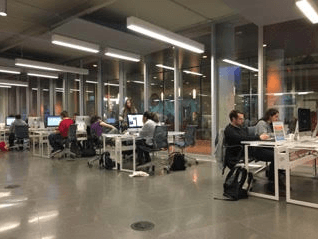UMW’s IT brings changes and progress to internet on campus
4 min read
Ashley Chung | Blue & Gray Press
By ANDREW PETTERSON
Hall Cheshire, the new Chief Information Officer of the University, and one of the heads of the IT department, discussed the significant role that cloud technology will begin to play in everyday- life at UMW in the near future. Students may experience a change in their internet connection as the department of Information Technologies plans to bring a third-party cloud company aboard.
“As we continue to use more and more data, the servers at UMW won’t be able to handle the traffic alone, so it is one of the IT department’s main goals to find a suitable third-party cloud company that will keep our data secure, stable and ready to use,” Chesire said. Because less server space would be used under cloud technologies, it may be possible to expect faster network speeds if the technology is implemented.
The proliferation of cloud technology at UMW and other universities across the nation and the world will also enable increased collaboration between institutions, providing access to previously unattainable resources- one of the IT department’s main goals.
Most UMW students have experienced the bittersweet nature of internet shutdown or slow wireless connection on campus from time to time. Whether connecting with Apogee, UMW, UMW-Guest, or even UMW-Secured, chances are at some point students have been met with no Wi-Fi and error messages.
When wireless connections go faulty and students are one log-in attempt beyond the breaking point, they may often wonder who is behind the campus’ internet.
The department in charge of correcting internet errors and establishing greater internet fluidity on campus is the department of Information Technology, a well-oiled machine consisting of eight offices and roughly 40 employees who work full and part-time to bring and maintain internet fluidity to campus.
According to Information Technologies’ mission statement from UMW’s IT strategic planning program that began in 2011, the employees work to allow academic and technological trends to come together.
The UMW IT mission statement reads that “academic excellence, the liberal arts and sciences, a student-centered learning environment, and outstanding teaching are at the core of what the University of Mary Washington has been and will continue to be. While this plan has been developed specific to technology and infrastructure support needs at UMW, key overall technology trends and issues in higher education have been considered and included.”
Technological advances on campus do not only affect students’ homework, social media or the bars of their phones, it also affects the academic reach of the campus, according to The Horizon Report, an annual summary of key overall technology trends and issues in higher education is an instrumental resource for the formation of IT policy at UMW and colleges across the globe.
In its most recent edition The Horizon report highlighted cross-institution collaboration, dedication to personalized learning, renovation of learning spaces, adoption of informal learning techniques, and as always- increased data literacy, as key components in advancing the evolution of teaching, learning, and creative inquiry.
The report then looks to the future, and stresses the significance of maintaining an effective and flexible IT system in response to the changing needs of educators, students and administrators. Long-term trends in the evolution of education include the expansion of learning analytics software that analyzes individual student performance, the development of adaptive learning technologies, software that adjusts to individual students’ needs as they learn, and the movement towards the “Internet of Things.”
The well-regarded paradigm of traditional academic theory, typified by one man standing in front of a class lecturing for 45-90 minutes, is beginning to change. Psychologists, educators, administrators, economists and social critics are at the forefront of this metamorphosis and are successfully disrupting the institution of education at the primary and secondary levels, as technological advances continue to increase.
To irrefutably challenge the rules of a game that had been played virtually the same way for hundreds of years is not something to be glossed over as students conveniently plug in laptops, phones, and whatever else into a centralized power strip in the HCC during this last week of classes.
Some majors rely on learning technologies offered by the IT department more than others. Senior physics major, John Robie said one of the biggest impacts on his academic experience has been the use of the 3-D printing lab. Just recently he used the lab to print pieces of a laser. “It offers the opportunity for more research, new research, real-world experience and lab experience,” Robie said about the technological opportunities on campus.
UMW IT is continuing to meet the educational, administrative and technological needs of the academic community . The 3D printing lab, integrated classrooms and learning spaces in the ITCC and the UC, the evolution of Canvas, and the new data center, are among IT innovations, making the learning process more efficient and enjoyable.
And as students progress into the uncharted technological future, UMW and the IT department have pledged to maintain their adaptive, student-oriented philosophy in making the university a more comprehensive and capable institution of higher learning.











